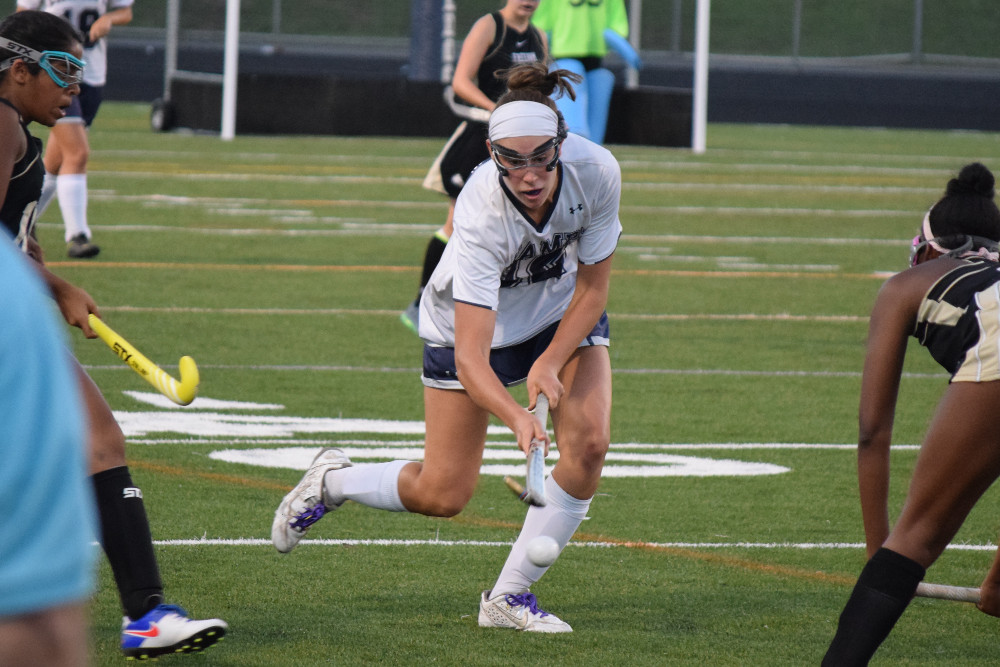
By Owen Gotimer
LoCoSports Editor-in-Chief
[twitter-follow screen_name=’BigO_Gotimer’]
Leesburg (September 7, 2016) – Sitting at my first high school field hockey game – the first varsity field hockey game in Loudoun’s history – I quickly realized I was outmatched. The sport was different and something I had only seen once before – at the collegiate level – so my understanding of the sport was limited.
At halftime, the umpire approached my photographer and me to see how we were doing. I told him that we were getting by but that a field hockey reference guide would have really helped in our reporting and learning process.
A few weeks later — and thanks to some of Loudoun’s field hockey coaches — that reference guide is here!
This is by no means an inclusive guide to everything you need to know about field hockey, but if you read this, you should be able to better understand the sport at an elementary level.
Big O’s Not-So Complete Reference Guide to Field Hockey
- There are eleven players on the field for each team, including the goalie.
- The goalies wear a lot of padding because the offense is shooting the ball at her at speeds up to 6,000 miles per hour. LOL JK! But the ball can hypothetically reach speeds of near 100 miles per hour.
- Goalies wear thick foam padding to deflect shots, but do not have a glove, as they cannot legally capture or cover the ball.
- Look Ma! No gloves!
- Players – not including the goalie – cannot kick the ball nor have it touch any part of their bodies.
- But the goalie can kick the heck out of the ball inside of her defensive circle.
- Players can only use the flat side of their hooked sticks.
- Also, all of the sticks are right-handed, so lefties need not apply.
- There is no “offsides” call.
- CHERRY PICKING IS LEGAL!
- Players can only score from inside the circle.
- AND for first shots on goal off penalty corners, the maximum allowable height that the ball can cross the goal line is 18-inches.
- Players can substitute on the fly except during a penalty corner.
- Players who can actually fly will be disqualified.
- Accidental fouls by the defense inside their circle or intentional fouls inside the 25-yard line result in a penalty corner.
- A player inserts the ball to teammates located outside the circle, while five defensive players – including the goalie – starts from behind their goal line and the other defenders starts at midfield.
- In order to score on a penalty corner, the full ball must travel outside of the circle before the ball is played on goal.
- Intentional fouls inside the circle, or fouls that stop a goal, result in a penalty stroke.
- An attacker pushes or flicks the ball from seven yards out.
- The ball is made of hard plastic.
- Do not throw or hit the ball at your little sister. It hurts.
- Varsity games consist of two, 30-minute halves.
- Also the coaches tried the explain all of the overtime rules, but I think it’s best to just cross that bridge when your team gets there.
- Players can “self-pass” where they restart play and pass to themselves without the need for a teammate to touch the ball first.
- The “I” in “TEAM”.
- The ball can be played at any height as long as the play isn’t dangerous
- If the ball is played above shin-guard-height and hits an opposing player’s body above the shin guard, the foul is generally on the person who caused the ball to hit a body part above the shin guard.
- For balls played into the feet or shin guards, the penalty is on the person who’s feet or shin guards are hit by the ball.
- A green card is a two-minute penalty, a yellow card is a five- or ten-minute penalty and a red card is an ejection.
- A purple card gets all of the fans free ice cream after the game.
Download this print-friendly version to bring with you to the game.
Stone Bridge head coach Richard Hayden, Riverside head coach Amy Oldknow and Briar Woods head coach Keil Ritterpusch contributed to this story.



